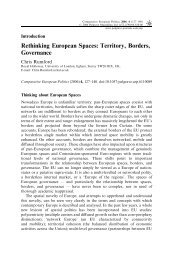Europeanisation, National Identities and Migration ... - europeanization
Europeanisation, National Identities and Migration ... - europeanization
Europeanisation, National Identities and Migration ... - europeanization
Create successful ePaper yourself
Turn your PDF publications into a flip-book with our unique Google optimized e-Paper software.
Introduction 5<br />
led civic-territorial model <strong>and</strong> the Eastern state-seeking ethnic model of nationalism<br />
<strong>and</strong> national identity formation. In the recent debate, this binary opposition has<br />
been criticised as too categorical <strong>and</strong> a-historical. As Rogers Brubaker (1999) has<br />
recently proposed, it is more appropriate to see the ethnic <strong>and</strong> civic elements as two<br />
general, but in their combination varying <strong>and</strong> historically changing, components<br />
of nationalism <strong>and</strong> national identity. Accordingly, it makes sense to relate – more<br />
systematically than has been done so far – the varying forms of nationalism <strong>and</strong><br />
national identity in the present to the different time zones of state formation <strong>and</strong><br />
nation-building in Europe as well as to the historical development <strong>and</strong> exp<strong>and</strong>ing<br />
waves of democratisation during the nineteenth <strong>and</strong> twentieth centuries. Regarding<br />
the different time zones of nation-state formation, there are crucial differences<br />
between the French <strong>and</strong> British rather political nationalism (first Western European<br />
zone), the German or Swiss more federal nationalism (second city-belt zone), the<br />
Polish <strong>and</strong> Hungarian peripheral nationalism (third continental interface zone), or<br />
the Russian imperial nationalism (fourth continental Empire-building zone).<br />
Regarding the historical waves of democratisation, the early nineteenth-century<br />
dividing line between civic-territorial <strong>and</strong> ethnic types of nationalism at the Rhine<br />
moved during the late nineteenth <strong>and</strong> early twentieth centuries further eastward,<br />
retreated again with the rise of fascism, Soviet communism <strong>and</strong> the European Cold-<br />
War divide, but was after 1945 moving again to Western Central Europe <strong>and</strong> is now<br />
exp<strong>and</strong>ing further eastward. In a parallel, the institutional components of citizenship<br />
<strong>and</strong> the civic elements of nationalism or national identity are not fixed entities, but<br />
historically changing in their weight <strong>and</strong> scope.<br />
European integration <strong>and</strong> its expansion toward<br />
the East<br />
The reconstruction of the pluralistic system of sovereign modern nation-states,<br />
whatever their individual configuration of statehood <strong>and</strong> civic or ethnic nationhood,<br />
in Western <strong>and</strong> Eastern Europe is, however, only one basic feature of the contemporary<br />
bridging of the Cold War European divide. Another feature is the<br />
deepening <strong>and</strong> widening process of European integration that started after the<br />
Second World War in the core of Western Europe, <strong>and</strong> which then included in<br />
several enlargement waves most parts of North Western, Southern <strong>and</strong> Northern<br />
Europe, intensified in cyclical <strong>and</strong> concentric movements, <strong>and</strong> is now on the move<br />
to exp<strong>and</strong> to the East. Although bound to the basic pluralism of the European state<br />
system <strong>and</strong> perhaps even an important rescuer of the European nation-state<br />
(Milward 1992), the European integration process has developed into a European<br />
system of transnational governance that essentially modifies the model of the<br />
modern nation-state. One crucial feature is the pooling of the member states’<br />
national sovereignty into the transnational European Community/Union level that,<br />
although with the basic consent of each member, nevertheless restricts <strong>and</strong> mediates<br />
the independent power of each individual nation-state. Another crucial feature is<br />
the functional integration of particular political, economic or social issues that were<br />
traditionally in the h<strong>and</strong>s of an individual state or society <strong>and</strong> are now merged into



